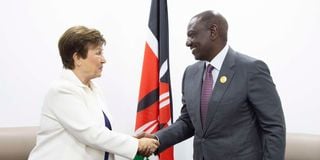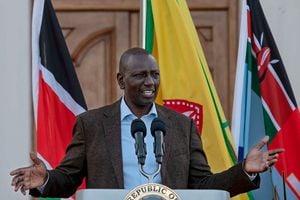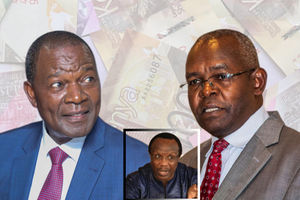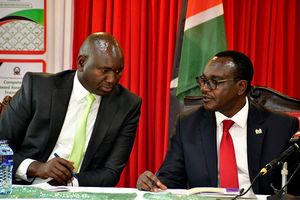
President William Ruto meets with IMF Managing Director Kristalina Georgieva.
Kenyans are facing more tax pain as the government starts implementing International Monetary Fund (IMF)-backed revenue growth measures that are expected to yield an additional Sh806 billion over the next three years.
The IMF said in a new assessment report on Kenya that the government will include in the 2024 Finance Bill all the tax measures proposed under the first year of its recently published Medium-Term Revenue Strategy (MTRS) covering the 2024/2025 to 2026/2027 fiscal years.
The demand by the IMF that the government immediately implements new tax measures comes at a time of elevated inflation and subdued economic activities, which has made it hard for the Kenya Kwanza administration to bring in new taxes and levies without opposition.
The MTRS envisages a gradual increase of Kenya’s tax to GDP ratio by five percentage points by 2027—effectively translating into additional revenue of Sh806 billion over three years going by the country’s projected 2024 nominal GDP of Sh16.124 trillion.
The tax-to-GDP ratio is expected to close the current fiscal year (ending June) at 15.1 per cent, with the IMF noting that Kenya is the only country in the East African Community that has experienced a protracted decline in its tax-to-GDP ratio since 2014.
In the first year of its implementation, the MTRS calls for a raft of changes including a motor vehicle circulation tax, reintroduction of minimum tax, withholding taxes on all imports and payments for supplies to public entities, and review of excise on alcohol and tobacco products.
Also Read: You’ve no choice, Ruto says on housing levy
There is also the expansion of the digital services tax to include local entities, a potential upward revision of rental income tax to match the corporate tax rate and introduction of VAT on non-core education services, excluding early childhood and basic education.
International Monetary Fund headquarters building in Washington, DC.
“Implementation is expected to start in early 2024 and be subject to a formal monitoring process at the ministerial level to ensure timely resolution of any emerging issues with the adoption of the MTRS,” said the IMF. “In this regard, the authorities have developed a well sequenced implementation matrix for the MTRS measures and intend to include in the 2024 Finance Bill all revenue measures envisaged under the first year of the MTRS.”
The Finance Bill will be submitted to Parliament by the end of April, as per the time lines set in Kenya’s budget making process.
Despite enhanced tax measures, however, revenue performance in the current fiscal year has remained below target, pointing to an economy that is increasingly struggling to keep up in terms of creating new jobs that generate revenue.
Latest revenue performance data from the National Treasury shows that in the five months to November 2023, tax revenue stood at Sh847.3 billion, which was Sh164 billion below the pro-rated target of Sh1.01 trillion.
In a letter to the IMF ahead of the programme review, Treasury Cabinet Secretary Njuguna Ndung’u attributed the underperformance to lower than anticipated income taxes and excise on account of weaker activity in key sectors such as banking, construction and ICT.
“The underperformance ... (was also due to) continued under execution of transfers to counties and public sector institutions (which affects payment of pay-as-you-earn tax from public sector employees) as well as for projects (which affects VAT collection),” said the CS in the letter, which was co-signed by Central Bank of Kenya governor Kamau Thugge.
The IMF published the report following the completion of the sixth review of Kenya's multi-year arrangement with the fund. The review unlocked a new disbursement of Sh110 billion, bringing the total disbursements to Sh418 billion ($2.6 billion).












